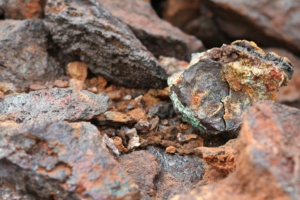Moving Forward: The Electric Vehicle Industry in the DRC
 The Democratic Republic of the Congo (DRC) is a country in Central Africa known for its rich deposits of copper, cobalt, zinc, lithium, oil and gold— all of which are essential to making the global clean energy transition. As companies globally look toward investing in a green future, particularly in the electric vehicle (EV) industry, mining sites in the DRC have become focal points of the supply chain necessary for constructing the batteries used in these cars.
The Democratic Republic of the Congo (DRC) is a country in Central Africa known for its rich deposits of copper, cobalt, zinc, lithium, oil and gold— all of which are essential to making the global clean energy transition. As companies globally look toward investing in a green future, particularly in the electric vehicle (EV) industry, mining sites in the DRC have become focal points of the supply chain necessary for constructing the batteries used in these cars.
Rising Demand for Rare Earth Metals
Investment in the DRC and other Central African nations reflects a growing interest in clean energy technologies. It also highlights the potential for increased engagement with the Congolese government to promote global trade of these valuable resources. As the EV and battery storage industries grow, the International Energy Agency (IEA) has predicted that total demand for lithium will rise by close to 90% by 2040. Similarly, nickel and cobalt will increase to between 60-70%.
The push is led by China, whose companies have been systematically buying and constructing refineries for these metals. Effectively this has made China indispensable to the EV supply chain. Approximately 80% of the DRC’s cobalt output is owned by Chinese companies. Many of these companies have recently come under fire for inhumane labor practices regarding the mines. For nations looking to get involved, the challenge now is to formalize the mining and refining processes while aligning labor practices with global standards. Additionally, the task is to distribute the profits from this trade to the Congolese government and its people.
Electric Vehicle Industry in the DRC
The DRC has long struggled with civil conflict. Fighting between the Congolese government and the militia group M23 has displaced millions of citizens. The DRC is considered one of the five most vulnerable countries in the world. The World Bank estimates that 73.5% of Congolese people live on less than $2.15 a day. Despite these challenges, the mining sector plays a vital role in the Congolese economy. In 2023, it grew by 18.2%, contributing to more than 70% of the overall gross domestic product (GDP) growth.
Most laborers, however, do not benefit from this growth. Often compared to modern-day slavery, Congolese freelance miners— referred to as “artisanal”— work in dangerous conditions for little more than a few dollars a day. These artisanal miners manually dig on the peripheries of excavation sites to sell to independent distributors. About 10-20% of Congolese cobalt is produced by artisanal and small-scale mining (ASM). These ASM sites, in particular, are associated with child labor, hazardous conditions and human rights violations.
There has been a surge in pressure on the Congolese government and cobalt-producing companies in the DRC to avoid ASM-produced cobalt entirely. However, others have pointed out that this runs the risk of cutting off the livelihoods of many Congolese workers. Rather, a formalization of the ASM industry is necessary to monitor high-risk situations and prevent human rights violations.
Formalization of the ASM Industry
The Mutoshi mine, located in the Katanga Province, has served as a pilot project to integrate ASM into industrially mined cobalt. Formalization processes include encouraging female participation, eliminating child labor and improving safety conditions. Similarly, directives such as the European Union (EU) Batteries Directive, the African Green Minerals Strategy and the DRC’s Interministerial Commission in Charge of Monitoring Child Labor in Artisanal Mining aim to improve ASM conditions.
Furthermore, negotiations like the U.S.-DRC-Zambia trilateral memorandum of understanding (MoU) aim to strengthen cooperation. Furthermore, they look to develop a cross-border integrated value chain for EV battery production. The MoU also seeks to raise awareness of investment and co-financing opportunities for the EV industry in the DRC.
Looking Ahead
With rising investments and exports in the mining sector, driven by improving mineral prices and growing public investment from the EV and battery industries, the DRC is poised to see continued favorable GDP growth over the next decade. In 2023, GDP growth was recorded at 7.8%. With the continued formalization of ASM and steadfast negotiation, the DRC can improve its global standing greatly as demand for EVs and battery storage techniques continues to grow.
– Sadie Claps
Sadie is based in Seattle, WA, USA and focuses on Business and Politics for The Borgen Project.
Photo: Unsplash
